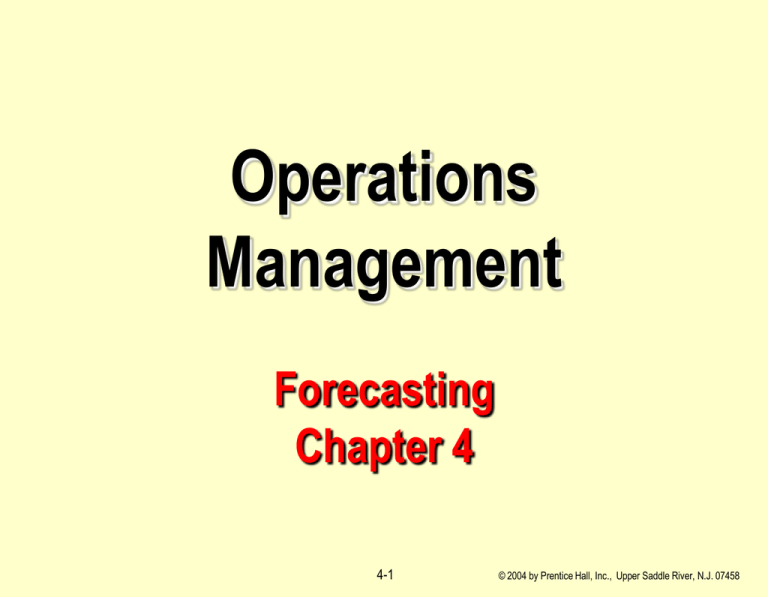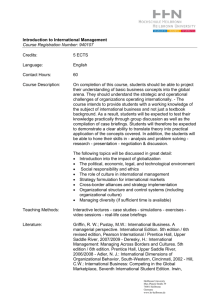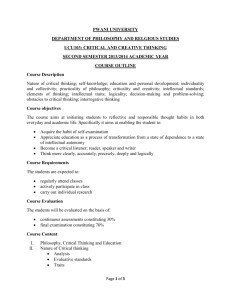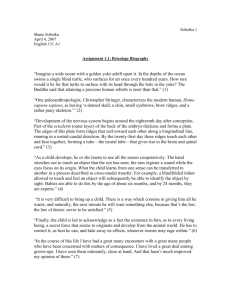Operations Management Forecasting
advertisement

Operations Management Forecasting Chapter 4 4-1 © 2004 by Prentice Hall, Inc., Upper Saddle River, N.J. 07458 What is Forecasting? Process of predicting a future event Sales will be $200 Million! Underlying basis of all business decisions Production Inventory Personnel Facilities 4-2 © 2004 by Prentice Hall, Inc., Upper Saddle River, N.J. 07458 Types of Forecasts Economic forecasts Address business cycle, e.g., inflation rate, money supply etc. Technological forecasts Predict rate of technological progress Predict acceptance of new product Demand forecasts Predict sales of existing product 4-3 © 2004 by Prentice Hall, Inc., Upper Saddle River, N.J. 07458 Types of Forecasts by Time Horizon Short-range forecast Up to 1 year; usually less than 3 months Job scheduling, worker assignments Medium-range forecast 3 months to 3 years Sales & production planning, purchasing, budgeting Long-range forecast 3+ years New product planning, facility location 4-4 © 2004 by Prentice Hall, Inc., Upper Saddle River, N.J. 07458 What Do We Forecast - Aggregation Clustering goods or services that have similar demand requirements and common processing, labor, and materials requirements: Red shirts White shirts Shirts $ Blue shirts Big Mac Quarter Pounder Regular Hamburger Pounds of Beef 4-5 What about Why units doofwe measurement aggregate? ? $ © 2004 by Prentice Hall, Inc., Upper Saddle River, N.J. 07458 Realities of Forecasting Forecasts are seldom perfect Most forecasting methods assume that there is some underlying stability in the system Both product family and aggregated product forecasts are more accurate than individual product forecasts 4-6 © 2004 by Prentice Hall, Inc., Upper Saddle River, N.J. 07458 Trend Component Response Persistent, overall upward or downward pattern Due to population, technology etc. Several years duration Time 4-7 © 2004 by Prentice Hall, Inc., Upper Saddle River, N.J. 07458 Seasonal Component Response Regular pattern of up & down fluctuations Due to weather, customs etc. Summer Time 4-8 © 2004 by Prentice Hall, Inc., Upper Saddle River, N.J. 07458 Cyclical Component Repeating up & down movements Due to interactions of factors influencing economy Usually 2-10 years duration Response Cycle Time 4-9 © 2004 by Prentice Hall, Inc., Upper Saddle River, N.J. 07458 Product Demand Demand for product or service Seasonal peaks Trend component Actual demand line Random variation Year 1 Year 2 4-10 Average demand over four years Year 3 Year 4 © 2004 by Prentice Hall, Inc., Upper Saddle River, N.J. 07458 Forecasting Approaches Qualitative Methods Quantitative Methods Used when situation is vague & little data exist Used when situation is ‘stable’ & historical data exist New products New technology Existing products Current technology Involves intuition, experience Involves mathematical techniques e.g., forecasting sales on Internet e.g., forecasting sales of color televisions 4-11 © 2004 by Prentice Hall, Inc., Upper Saddle River, N.J. 07458 Overview of Qualitative Methods Jury of executive opinion Pool opinions of high-level executives, sometimes augmented by statistical models Delphi method Panel of experts, queried iteratively Sales force composite Estimates from individual salespersons are reviewed for reasonableness, then aggregated Consumer Market Survey Ask the customer 4-12 © 2004 by Prentice Hall, Inc., Upper Saddle River, N.J. 07458 Overview of Quantitative Approaches Naïve approach Moving averages Exponential smoothing Trend projection Seasonal variation Time-series Models Linear regression Associative Models 4-13 © 2004 by Prentice Hall, Inc., Upper Saddle River, N.J. 07458 What is a Time Series? Set of evenly spaced numerical data Observing the response variable at regular time intervals Forecast based only on past values Assumes that factors influencing the past and present will continue to influence the future Example Year: Sales: 1999 78.7 2000 63.5 4-14 2001 89.7 2002 93.2 2003 92.1 © 2004 by Prentice Hall, Inc., Upper Saddle River, N.J. 07458 Naive Approach Assumes demand in next period is the same as demand in most recent period e.g., If May sales were 48, then June sales will be 48 Sometimes cost effective & efficient © 1995 Corel Corp. 4-15 © 2004 by Prentice Hall, Inc., Upper Saddle River, N.J. 07458 Simple Moving Average Forecast Ft = Demand in Previous n Periods n A t–1 + A +A t–3 A t–1 + A t–2 + A t–3 t–2 +A t–4 4 Ft = 3 4-16 © 2004 by Prentice Hall, Inc., Upper Saddle River, N.J. 07458 Weighted Moving Average Forecast = Σ (Weight for period n) (Demand in period n) Σ Weights Ft = .4A t–1 + .3A t–2 + .2A t–3 + .1A Ft = .7A t–1 + .2A t–2 + .1A t–3 4-17 t–4 © 2004 by Prentice Hall, Inc., Upper Saddle River, N.J. 07458 Exponential Smoothing Method Form of weighted moving average Weights decline exponentially Most recent data weighted most Requires smoothing constant () Ranges from 0 to 1 Subjectively chosen Involves little record keeping of past data 4-18 © 2004 by Prentice Hall, Inc., Upper Saddle River, N.J. 07458 Exponential Smoothing Forecast = Ft (Demand last period) + (1 – ) ( Last forecast) = A t–1 + (1 – ) (F t–1) = A t–1 + F t–1 – F t–1 = F t–1 + (A t–1 – F t–1) Forecast = Last forecast + (Last demand – Last forecast) 4-19 © 2004 by Prentice Hall, Inc., Upper Saddle River, N.J. 07458 Exponential Smoothing with Trend Adjustment Forecast = Exponentially smoothed forecast (Ft ) + Exponentially smoothed trend (Tt ) Tt = (Forecast this period – Forecast last period) + (1- ) (Trend estimate last period) = (Ft - Ft-1) + (1- )Tt-1 4-20 © 2004 by Prentice Hall, Inc., Upper Saddle River, N.J. 07458 Seasonal Variation Quarter 1 2 3 4 Total Average Year 1 Year 2 Year 3 Year 4 45 335 520 100 70 370 590 170 100 585 830 285 100 725 1160 215 1000 250 1200 300 1800 450 2200 550 Actual Demand Seasonal Index = Average Demand = 45 250 = 0.18 Forecast for Year 5 = 2600 4-21 © 2004 by Prentice Hall, Inc., Upper Saddle River, N.J. 07458 Seasonal Variation Quarter 1 2 3 4 Year 1 Year 2 Year 3 45/250 = 0.18 335/250 = 1.34 520/250 = 2.08 100/250 = 0.40 70/300 = 0.23 370/300 = 1.23 590/300 = 1.97 170/300 = 0.57 Year 4 100/450 = 0.22 100/550 = 0.18 585/450 = 1.30 725/550 = 1.32 830/450 = 1.84 1160/550 = 2.11 285/450 = 0.63 215/550 = 0.39 Quarter Average Seasonal Index Forecast 1 2 3 4 (0.18 + 0.23 + 0.22 + 0.18)/4 = 0.20 (1.34 + 1.23 + 1.30 + 1.32)/4 = 1.30 (2.08 + 1.97 + 1.84 + 2.11)/4 = 2.00 (0.40 + 0.57 + 0.63 + 0.39)/4 = 0.50 650(0.20) = 130 650(1.30) = 845 650(2.00) = 1300 650(0.50) = 325 4-22 © 2004 by Prentice Hall, Inc., Upper Saddle River, N.J. 07458 Overview of Quantitative Approaches Naïve approach Moving averages Exponential smoothing Trend projection Seasonal variation Time-series Models Linear regression Associative Models 4-23 © 2004 by Prentice Hall, Inc., Upper Saddle River, N.J. 07458 Linear Regression Factors Associated with Our Sales • Advertising • Pricing Sales • Competitors • Economy • Weather Independent Variables Dependent Variable 4-24 © 2004 by Prentice Hall, Inc., Upper Saddle River, N.J. 07458 Sales (in $ hundreds of thousands) Scatter Diagram Sales vs. Payroll 4 3 2 Now What? 1 0 0 1 2 3 4 5 6 7 8 Area Payroll (in $ hundreds of millions) 4-25 © 2004 by Prentice Hall, Inc., Upper Saddle River, N.J. 07458 Types of Forecasts by Time Horizon Short-range forecast Up to 1 year; usually less than 3 months Job scheduling, worker assignments Medium-range forecast Time Series Associative 3 months to 3 years Sales & production planning, budgeting Qualitative Long-range forecast 3+ years New product planning, facility location 4-26 © 2004 by Prentice Hall, Inc., Upper Saddle River, N.J. 07458 Forecast Error 4-27 © 2004 by Prentice Hall, Inc., Upper Saddle River, N.J. 07458 Forecast Error E t = A t – Ft –3 +5 4-28 © 2004 by Prentice Hall, Inc., Upper Saddle River, N.J. 07458 Forecast Error - CFE CFE – Cumulative sum of Forecast Errors CFE = Et •Positive errors offset negative errors •Useful in assessing bias in a forecast 4-29 © 2004 by Prentice Hall, Inc., Upper Saddle River, N.J. 07458 Forecast Error - MSE MSE – Mean Squared Error MSE = Et n 2 Accentuates large deviations 4-30 © 2004 by Prentice Hall, Inc., Upper Saddle River, N.J. 07458 Forecast Error - MAD MAD – Mean Absolute Deviation MAD = |Et | n Widely used, well understood measurement of forecast error 4-31 © 2004 by Prentice Hall, Inc., Upper Saddle River, N.J. 07458 Forecast Error - MAPE MAPE – Mean Absolute Percent Error MAPE = 100 |Et | / At n Relates forecast error to the level of demand 4-32 © 2004 by Prentice Hall, Inc., Upper Saddle River, N.J. 07458 Forecast Error Et = At – Ft CFE = Et MSE = Et 2 n MAD = |Et | n MAPE = 100 |Et | / At n 4-33 © 2004 by Prentice Hall, Inc., Upper Saddle River, N.J. 07458 Monitoring & Controlling Forecasts We need a TRACKING SIGNAL to measure how well the forecast is predicting actual values TS = Running sum of forecast errors (CFE) Mean Absolute Deviation (MAD) = Et | Et | / n 4-34 © 2004 by Prentice Hall, Inc., Upper Saddle River, N.J. 07458 Plot of a Tracking Signal Signal exceeded limit + Tracking signal CFE / MAD Upper control limit 0 - Acceptable range Lower control limit Time 4-35 © 2004 by Prentice Hall, Inc., Upper Saddle River, N.J. 07458 Forecasting in the Service Sector Presents unusual challenges special need for short term records needs differ greatly as function of industry and product issues of holidays and calendar unusual events 4-36 © 2004 by Prentice Hall, Inc., Upper Saddle River, N.J. 07458 Forecast of Sales by Hour for Fast Food Restaurant 20 15 10 5 0 +11-12 +1-2 11-12 12-1 1-2 2-3 +3-4 +5-6 3-4 4-5 5-6 4-37 +7-8 +9-10 6-7 7-8 8-9 9-10 10-11 © 2004 by Prentice Hall, Inc., Upper Saddle River, N.J. 07458 Summary Demand forecasts drive a firm’s plans - Production - Capacity - Scheduling Need to find the forecasting method(s) that best fit our pattern of demand – no one right tool - Qualitative methods e.g. customer surveys - Time series methods (quantitative) rely on historical demand to predict future demand - Associative models (quantitative) use historical data on independent variables to predict demand e.g. promotional campaign Track forecast error to determine if forecasting model requires change 4-38 © 2004 by Prentice Hall, Inc., Upper Saddle River, N.J. 07458



